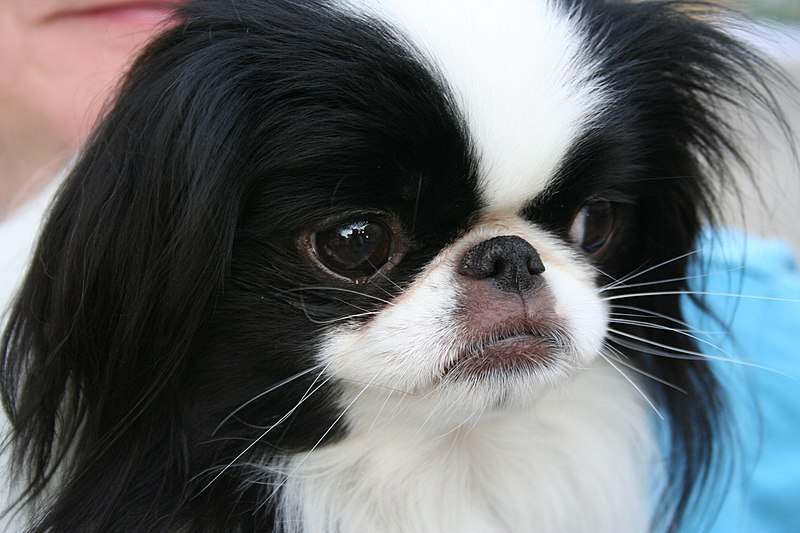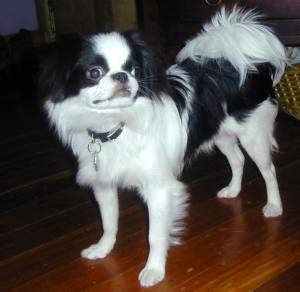Japanese Chin (Chin) small dog breed
 |
| Japanese Chin dog |
The Japanese Chin (狆), also known as the Japanese Spaniel) is the dog of Japanese royalty. A lap dog and companion dog, this toy breed has a distinctive heritage.
Appearance
 |
| Alert Japanese Chin dog |
Chin have straight, silky, profuse long hair that is most often black and white, or white and black, with other acceptable colorations being red and white (which includes lemon yellow and white), sable and white and, rarely, black and white with tan points, also commonly referred to as a “Tri-Color.” They have heavily feathered tails that curl up over their backs with the long hair cascading down one side, often reaching the floor; the chest, neck and shoulder area is also heavily coated, with the hair springing away from the body creating the appearance of a thick ruff.
The Chin is considered a “head breed,” with a slightly oversized head that is square or blocky with a slight rounding between the ears; this rounding should not be so round as to be domed in appearance. It is ideal to have a white hourglass-shaped patch of hair over the face and skull; this patch commonly has a black spot or blaze in the center of the skull which is known as a Buddha's Thumbprint. This designation is often attributed to the Emperor Ming of Han China, who is said to have owned many of these dogs. The face should have an "oriental" appearance, with a short, upturned muzzle and large, wide-set eyes that have white visible in the inner corners, creating an astonished expression.
Temperament
 |
| Cute Japanese Chin dog |
The Chin will bark for the purpose of alerting the household to the arrival of a visitor or something out of the ordinary, but are otherwise very quiet.
Chin were bred for the purpose of loving and entertaining their people. While typically a calm little dog, they are well known for performing many enjoyable antics such as the “Chin Spin,” in which they turn in rapid circles; dancing on their hind legs while pawing their front feet, clasped together, in the air; and, some even “sing,” a noise that can range from a low trill to a higher, almost operatic quality noise, and which sounds much like “boooo.”
Health
 |
| Puppy |
A 6 month old Japanese Chin
Care
 |
| Love, Family |
Diet is an important factor in the health and condition of the Chin, with many Chin being very sensitive or allergic to corn. Maintaining a Chin on a high quality kibble that contains no corn will do much to avoid skin and allergy conditions.
Due to low exercise requirements, the Chin makes a perfect condominium or apartment pet. The use of "housetraining pads" is recommended. The Chin is very easy to housetrain with many learning the use of a doggie door (some as young as 8 weeks old) in a day’s time with assistance from their person. Similarly, it is very easy to train them to the housetraining pads, or even a litter box, by limiting their area until they have mastered use of the pads or litter box.
History
 |
| Little bit confused |
The Chin were the dogs of Japanese nobility and each noble house bred to their own standards. Because of this, there are many variations of the Chin in any area from size to coat density, eye set, personality, whether they are compact and well-muscled or slender-boned and fragile in appearance, etc.
Professor Ludvic von Schulmuth studied canine origins by studying the skeletal remains of dogs found in human settlements as long as the 8th millennium BC.[citation needed] The Professor created a genealogical tree of Tibetan dogs that shows the "Gobi Desert Kitchen Midden Dog", a scavenger, evolved into the "Small Soft-Coated Drop-Eared Hunting Dog". From this dog evolved the Tibetan Spaniel, Pekingese, and Japanese Chin`. Another branch coming down from the "Kitchen Midden Dog" gave rise to the Papillon and Long-haired Chihuahua and yet another "Kitchen Midden Dog" branch to the Pug and Shih Tzu.
Though there is some documentation that indicates Portuguese sailors introduced the breed to Europe in the 17th century by presenting some to Catherine of Braganza, Queen Consort to King Charles II of England, there is more credible evidence that the first Chin were gifted by the Emperor of Japan to an American naval officer, Matthew Calbraith Perry, when Perry visited the Orient in 1853 to open trade with the East. Perry was gifted with a total of seven (7) Chin; however, only two survived the passage back. Again, there is controversy over whether Perry gave the two to Franklin Pierce, President of the United States, gave them to James Stirling, Rear admiral of the Royal Navy to take to Queen Victoria, or gave them to his daughter , Caroline Slidell,after returning from Japan. Caroline was the wife of August Belmont.
No comments:
Post a Comment